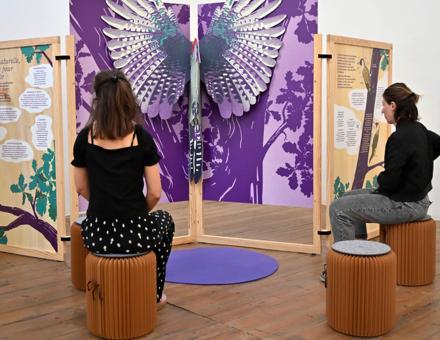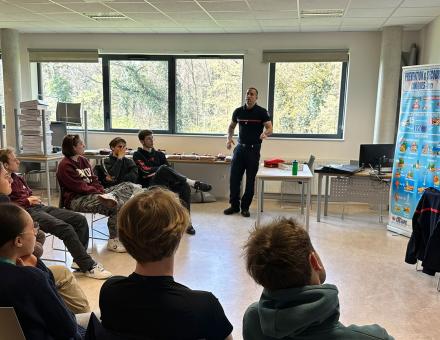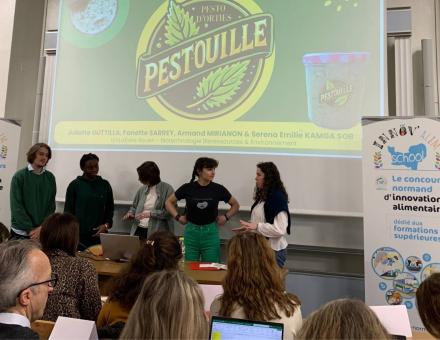On the Amiens campus, a pedagogical project invites a group of 3rd year students in energy engineering and digital systems to design a video game to help pre-engineering students.
In the family of original educational initiatives, I ask for the Towering Inferno! With the help of the Direction de l'innovation pédagogique, Marjorie Russo, teacher-researcher at UniLaSalle Amiens, supervised this serious game project carried out by four student-engineers from the Amiens campus.
The objective of the project is simple: to design a game with an educational purpose to allow pre-engineering students who are not familiar with the C language, which is the basis of algorithmic and computer programming, to progress through a playful experience.
What makes it special? This video game was entirely designed and developed by four 3rd year engineering students in Energy and Digital Systems Engineering, Damien Lam, Nathaniel Handalena, Mohamed Smail and Nanwasse Silue.
Under the guidance of Marjorie Russo, a teacher-researcher in computer science at UniLaSalle Amiens, our four students spent the 75 hours devoted to this project imagining the scenario, the characters and the dialogues and then developing the game itself.
"Offering a different pedagogical approach, based on games, helps to remove the blocks that some students have".
The player is propelled into a virtual world, at the foot of a 6-story "infernal" tower where each level corresponds to a chapter of the course. His goal? Reach the top of the tower and solve the final enigma to free himself from the virtual world and join the classrooms of the Amiens campus. To do this, he must answer questions, put a code in order, and other tests concocted by the students who developed the game. If the player fails, he or she is offered an easier riddle with a reminder of the course.
"Offering a different teaching approach, based on games, helps to overcome the obstacles faced by some students," says Marjorie Russo, who supervises the module. "The engineering students who designed the game had also taken the algorithms and programming course during their pre-engineering cycle, which enabled them to identify the notions that had caused them problems right away and to orient the content of the game to overcome these difficulties.
"We wanted to create our own fictional world to remove as many restrictions as possible," explains Nathaniel Handalena, one of the four students who designed the game. A choice that required inventing a design and imagining a scenario according to the rules of writing novels: initial situation / disturbing element / adventures / denouement / conclusion. "After testing several methods and software to model our world, we opted for Minecraft and its sandbox to build our tower, and added some animations using Photoshop and VTS Editor" [editor of serious game available to our students].
"We had our first experience with "Blue Print" programming, which was very enriching for the developer I want to become".
"We wanted an interactive and intuitive story that makes the student want to practice in a fun way," adds Damien Lam, also a member of the design team. "While having fun, they discover the history of the "game" and acquire an understanding of the programming language. Being, like the first-year students, a generation that grew up with the Internet, we were inspired by its culture. To capture the attention of the players, we thought it would be interesting to orient our scenario towards this domain," explains Damien, who admits that the team took advantage of the opportunity to slip in a few little "secrets" referring to this Internet culture.
The exercise allowed our four engineering students to fully mobilize their knowledge of C language, but not only. "I think I gained in technical skills, but also in relational skills" confirms Damien. Organization over a long period of time, teamwork, internal communication but also determination, originality, motivation and ingenuity were indeed key elements in the success of this project. "We had our first experience with "Blue Print" programming, which was very enriching for the developer I want to become," says Nathaniel, who also emphasizes that he understood the difference between understanding and mastering. "To explain the C language through metaphor, you must first master it well, so we reinforced our skills in this area.
"A fun way to retain important C language concepts."
If the students who are the most experienced in the C language find the game rather easy, they all agree that the game format is a good solution to stimulate motivation to revise and to facilitate the understanding and memorization of the basics.
"I didn't understand the tables very well, and by playing the game, I was able to overcome this problem," says Baptiste, a first-year engineering student, who finds the Towering Inferno "a great, well-thought-out way to learn in a fun way, which can be very motivating and helpful.
An impression shared by Alexia, in the same class. "The game allows us to better understand the functioning of the different elements of the C language thanks to the different examples. In addition, the technical memos given in the game also make it easier to remember in the long run or in case of doubt how to use each function."
Accessible, complete questions that go back to all the important elements of the course. For Amine, "the game can provide a motivating challenge, because you want to pass each test on the first try. In short, "it's a fun way to remember the important concepts of the C language."






